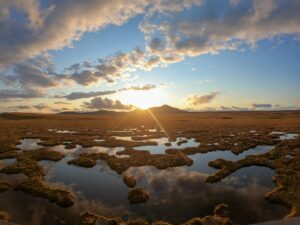A new report has highlighted how the restoration of degraded peatland in Wales can improve water security, as efforts to do so accelerated at record pace over 2021/22.
Natural Resources Wales found the Welsh Government target to restore 650 hectares of peatland has been surpassed, as over 1000 hectares were restored, the equivalent of 1400 football pitches.
Peatlands, otherwise known as bog, mires or moors, are home to 70% of the UK’s drinking water, meaning their restoration is crucial following a month where Wales only received 56% of its expected rainfall.
Wet bogs can also contain up to 90% water, acting as a natural barrier to spreading wildfires and reduce the risk of floods further downstream.

Climate Change Minister, Julie James, said: ‘Bogs might not sound very glamorous, but they are Wales’ unsung heroes – especially during prolonged periods of dry or wet weather, like we have seen recently.
‘When peat bogs are in a good state of repair, they are our most efficient terrestrial carbon sinks; they are home to a wide range of wildlife and plants, and even help purify our drinking and bathing water.
‘Their restoration is vital to our response to the nature and climate emergencies so this report by NRW is very welcome news and I want to thank them for their hard work in accelerating their efforts to peat the target!’
Peatlands act as an efficient carbon store and is able to retain more carbon in the soil than forests of the same capacity are able to store.
The 4% of Wales covered by peatlands, stores up to 30% of the country’s soil carbon, but if damaged peatlands can release this carbon into the atmosphere.
The Welsh government’s National Peatland Action Programme enables flexibility in agreements and funding to ensure peatland restoration goes ahead in a number of landowning circumstances.
National Peatland Action Programme Project Manager, Dr Rhoswen Leonard said: ‘Our success in delivering restoration activity on over 1000 hectares of peatland in a year reflects the collective passion of the NPAP team and our partners to achieve high nature, low carbon targets for the benefit of the people of Wales.
‘In support, Welsh Government inspires the urgency and Natural Resources Wales and our partners provide the momentum and joined-up capacity to make this Programme a success.
‘Peatland restoration is a big growth area to address the climate and nature emergencies, so we’re very grateful to our partners, for their impressive successes in re-wetting peat, and to the innovative contractors who adapted techniques and equipment to address the challenges on site.’
Photo by K B












